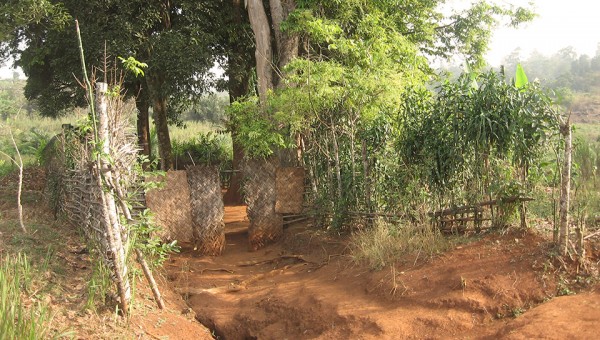
The Sacred Natural Sites Initiative regularly features “Conservation Experiences” of custodians, protected area managers, scientists and others. This post features the experiences of Mr. Sébastien Luc Kamga-Kamdem PhD who currently works with the The Central African Protected Areas Network (RAPAC). Sébastien has been working on sacred natural sites in Bandjoun, West Cameroon and has identified the need for cultural as well as biological restoration methods for these special places. Click here to read the full case study on “Sacred Sites in Bandjoun, West Cameroon“.

Located in the administrative center of Bandjoun, Tchuep-Poumougne is a scared area of hight spiritual value. In the past the area of its infuence covered the whole of Pete Quarter. Because of urbanisation its surrounding ecological values have drastically declined and only the core of the sanctuary remains. Photo; Sébastien Luc Kamga-Kamdem (2008).
In the Bandjoun territory in the West of Cameroon lie various sites perceived as sacred by the local people. They are the core remnants of sites that were historically a lot more extensive representing the identity of tribes and communities in the region such as family shrines and community gathering places. The shared function of most sites is worship of the gods. Even though the ecology of these sacred natural sites has received little attention to date, they are known to harbour animals and plants which have largely disappeared from the surrounding areas.
Traditional leaders stated that the survival of sacred areas is not threatened because these areas are strongly linked with the community identity and thus well taken care off. Nevertheless, they worry about the strength of the cultural fabric that has upheld sacred natural sites. Changing attitude of young people who are becoming increasingly materialistic cause them to disobey toboos and show lest respect for ancestral beliefs. Today, many people use sacred areas without informing their custodian, indicating the erosion of cultural norms. More key threats have been identified, yet most are under debate among the local people themselves.
Over the centuries, the Bandjoun people have developed an ancestral management system of sacred natural sites. The location of natural and semi-natural sacred sites is identified by the initiated spiritual leaders (MkamSi). While most have been long-established, the location of a sacred area is not immutable and can be changed for reasons like road construction or socio-political reorientation. Generally, each sacred area comes under the responsibility of a custodian called Nongtchuép. He is responsible for making offerings and sacrifices, for which he can also mandate a representative. The initiated elders are universal custodians. They have the right to work in all worship sites.
The greatest progress supporting the conservation of sacred areas would be their legal recognition, increased public awareness, reduced negative changes in land use and a better recognition of their socio-cultural and ecological importance. To achieve all of the above will require involvement of stakeholders at local, national and international levels. Read more.






